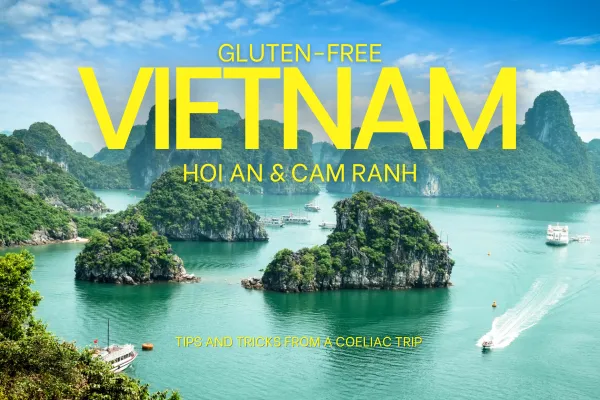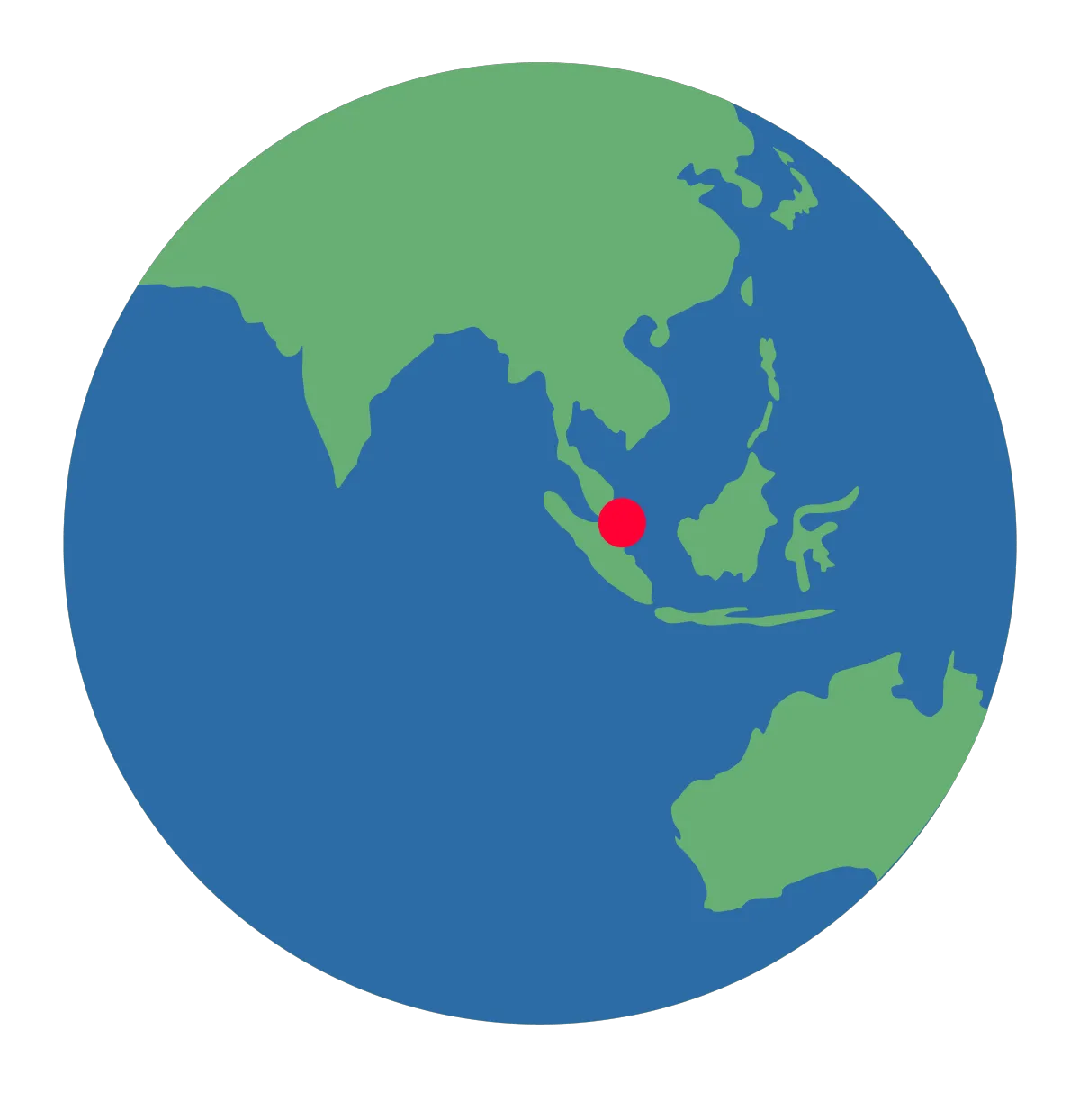
International Gluten Free
Gluten-Free Travel
Learn more about our international adventures
HOME / Travel the World

Gluten-Free Holiday in Vietnam
Vietnam: Two Trips, Two Tales
Travelling gluten-free through Hoi An and Cam Ranh.
“Vietnam gets under your skin; the fragrance of lemongrass, lanterns drifting on rivers, and the deafening whirr of motorbikes.”
It’s a place that stays with you, with food that is fresh and vibrant. But for those of us who live gluten free, it takes planning, research and clear communication.
This year, I visited Vietnam twice, first to Hoi An in summer, then again in October to the Cam Ranh coastline. It was both frustrating and unexpectedly joyful.
Hoi An: Beautiful, but tricky
Hoi An is a photographer’s dream, golden yellow walls, hanging lanterns, riverboats, but my first hotel didn’t quite understand celiac gluten free.
I’d emailed ahead, shared my Vietnamese translation card, and thought I’d covered everything. The hotel was able to provide gluten free bread, I’d even read reviews about their gluten-free food. Still, there was cross-contamination on the first night that caught me out.
After that, I stuck to fruit and boiled eggs at breakfast, and for a few days, I didn’t even want to try another restaurant.
Finding Food (and Confidence)
I travel light and rarely pack emergency food. I’m the only coeliac in the family, so if I go hungry for a bit, it’s manageable. I always tell myself there’ll be something, rice, fruit, crisps(!).
My hunt lead me to Xanh Xanh Supermarket. It became a tiny lifeline; gluten-free nuts and crackers with a jar of peanut butter. Not glamorous, but it kept me going and let me enjoy Hoi An without anxiety.
When I finally ate out again, I found some real gems.
Gluten-Free Restaurants in Hoi An
Mate Restaurant
A revelation. They have a completely separate kitchen area for gluten-free, you can see the chef going into a separate space to make your order. The staff understand everything from gluten-free soy sauce to dedicated utensils. Over 60 gluten-free dishes, everything I tried was excellent.
The Silent Garden
The owner immediately understood gluten free and showed me what I could safely order. Most dishes could be adapted.
A Little Kitchen Bep Nho
Similar to The Silent Garden. They knew exactly how to avoid cross-contamination. I had Cao Lau noodles, very satisfying after meals of peanut butter and crackers.
Dingo Deli
A Western café with a dedicated gluten-free kitchen and separate gluten-free cake display cabinet. Each gluten-free order comes with a little “gf” flag. They even give out free Vietnamese gluten-free translation cards. I had a burger and fries, plus carrot cake and chocolate cake (yes, both).
Tip: All these restaurants deliver via Grab in the Hoi An area. Check the 'Find Me Gluten Free’ app for more (including a 100% gluten-free Bun Cha restaurant we didn’t get round to visiting).
Hoi An taught me to have a plan B, that my communication needed work and that it’s possible to trust again after a rocky start. I’d go back in a heartbeat, armed with better questions and a list of those wonderful restaurants.
Cam Ranh Coast: A Pleasant Surprise
By October, I was back in Vietnam, this time for a beach holiday along the Cam Ranh coastline. I’d prepared myself to trek to Nha Trang city for safe food if needed. As it turned out, I didn’t have to.
Amiana Cam Ranh
I emailed ahead, attached my Vietnamese gluten-free card, asked about cross-contamination and if I could discuss food with the chef. The F&B manager responded with a full gluten-free menu, Vietnamese and Western options. When there, the breakfast waitress invited me to pre-order breakfast items each night.
Everything I ate was safe and fresh (though I’d skip the gluten-free bread).
JW Marriott Cam Ranh
If I could give them six stars, I would.
Before I even mentioned cross-contamination, the staff brought it up. The head chef and sous chef sat with me to discuss details. They even offered to open a separate kitchen, which I felt wasn’t necessary, but it made feel very safe.
Each morning, they prepared gluten-free breakfasts away from the buffet, adapted any dish on request, and even created off-menu meals just for fun. It felt like a conversation about delicious food, not just a negotiation about soy sauce and clean woks.
Lessons from Vietnam
Across both trips, a few key lessons stood out, ones echoed by many gluten-free travellers:
Vietnamese cuisine is naturally gluten-friendly; rice, rice noodles, and fish sauce are staples, but soy sauce, Knorr, fish sauce containing wheat and shared fryers can trip you up.
Translation cards are lifesavers but they have to mention cross-contamination and hidden gluten in common Vietnamese seasonings.
Communication is everything. Email hotels in advance, ask detailed questions about cross-contamination procedures, and speak directly with the chef or F&B manager if you can.
Self-advocacy matters. The difference between my Hoi An and Cam Ranh experiences came down to how clearly I communicated.
It’s not enough to ask, ‘Do you have gluten-free food?’ You need to check how they prepare it, utensils, sauces, fryers, everything.
A Gluten-Free Takeaway
Travelling gluten free in Vietnam can feel unpredictable. If there’s one takeaway from my trips there this year, it’s this:
Research, communicate, and advocate, more than you think is necessary.
Sometimes, despite your best planning, things won’t work out. But other times, they really do. Hoi An taught me about resourcefulness and communication. Cam Ranh reminded me what it feels like not to have to compromise.
When gluten-free travel works, it’s not just about avoiding getting sick. It’s about the joy of sitting down to a meal of new flavours, in a different country, knowing you’ll be fine.
Planning a trip to China? Check out Natasha's Celiac China website. Sign up for her newsletter and get a copy of her Mandarin translation card.

Gluten-Free Holiday in Vietnam
Vietnam: Two Trips, Two Tales
Travelling gluten-free through Hoi An and Cam Ranh.
“Vietnam gets under your skin; the fragrance of lemongrass, lanterns drifting on rivers, and the deafening whirr of motorbikes.”
It’s a place that stays with you, with food that is fresh and vibrant. But for those of us who live gluten free, it takes planning, research and clear communication.
This year, I visited Vietnam twice, first to Hoi An in summer, then again in October to the Cam Ranh coastline. It was both frustrating and unexpectedly joyful.
Hoi An: Beautiful, but tricky
Hoi An is a photographer’s dream, golden yellow walls, hanging lanterns, riverboats, but my first hotel didn’t quite understand celiac gluten free.
I’d emailed ahead, shared my Vietnamese translation card, and thought I’d covered everything. The hotel was able to provide gluten free bread, I’d even read reviews about their gluten-free food. Still, there was cross-contamination on the first night that caught me out.
After that, I stuck to fruit and boiled eggs at breakfast, and for a few days, I didn’t even want to try another restaurant.
Finding Food (and Confidence)
I travel light and rarely pack emergency food. I’m the only coeliac in the family, so if I go hungry for a bit, it’s manageable. I always tell myself there’ll be something, rice, fruit, crisps(!).
My hunt lead me to Xanh Xanh Supermarket. It became a tiny lifeline; gluten-free nuts and crackers with a jar of peanut butter. Not glamorous, but it kept me going and let me enjoy Hoi An without anxiety.
When I finally ate out again, I found some real gems.
Gluten-Free Restaurants in Hoi An
Mate Restaurant
A revelation. They have a completely separate kitchen area for gluten-free, you can see the chef going into a separate space to make your order. The staff understand everything from gluten-free soy sauce to dedicated utensils. Over 60 gluten-free dishes, everything I tried was excellent.
The Silent Garden
The owner immediately understood gluten free and showed me what I could safely order. Most dishes could be adapted.
A Little Kitchen Bep Nho
Similar to The Silent Garden. They knew exactly how to avoid cross-contamination. I had Cao Lau noodles, very satisfying after meals of peanut butter and crackers.
Dingo Deli
A Western café with a dedicated gluten-free kitchen and separate gluten-free cake display cabinet. Each gluten-free order comes with a little “gf” flag. They even give out free Vietnamese gluten-free translation cards. I had a burger and fries, plus carrot cake and chocolate cake (yes, both).
Tip: All these restaurants deliver via Grab in the Hoi An area. Check the 'Find Me Gluten Free’ app for more (including a 100% gluten-free Bun Cha restaurant we didn’t get round to visiting).
Hoi An taught me to have a plan B, that my communication needed work and that it’s possible to trust again after a rocky start. I’d go back in a heartbeat, armed with better questions and a list of those wonderful restaurants.
Cam Ranh Coast: A Pleasant Surprise
By October, I was back in Vietnam, this time for a beach holiday along the Cam Ranh coastline. I’d prepared myself to trek to Nha Trang city for safe food if needed. As it turned out, I didn’t have to.
Amiana Cam Ranh
I emailed ahead, attached my Vietnamese gluten-free card, asked about cross-contamination and if I could discuss food with the chef. The F&B manager responded with a full gluten-free menu, Vietnamese and Western options. When there, the breakfast waitress invited me to pre-order breakfast items each night.
Everything I ate was safe and fresh (though I’d skip the gluten-free bread).
JW Marriott Cam Ranh
If I could give them six stars, I would.
Before I even mentioned cross-contamination, the staff brought it up. The head chef and sous chef sat with me to discuss details. They even offered to open a separate kitchen, which I felt wasn’t necessary, but it made feel very safe.
Each morning, they prepared gluten-free breakfasts away from the buffet, adapted any dish on request, and even created off-menu meals just for fun. It felt like a conversation about delicious food, not just a negotiation about soy sauce and clean woks.
Lessons from Vietnam
Across both trips, a few key lessons stood out, ones echoed by many gluten-free travellers:
Vietnamese cuisine is naturally gluten-friendly; rice, rice noodles, and fish sauce are staples, but soy sauce, Knorr, fish sauce containing wheat and shared fryers can trip you up.
Translation cards are lifesavers but they have to mention cross-contamination and hidden gluten in common Vietnamese seasonings.
Communication is everything. Email hotels in advance, ask detailed questions about cross-contamination procedures, and speak directly with the chef or F&B manager if you can.
Self-advocacy matters. The difference between my Hoi An and Cam Ranh experiences came down to how clearly I communicated.
It’s not enough to ask, ‘Do you have gluten-free food?’ You need to check how they prepare it, utensils, sauces, fryers, everything.
A Gluten-Free Takeaway
Travelling gluten free in Vietnam can feel unpredictable. If there’s one takeaway from my trips there this year, it’s this:
Research, communicate, and advocate, more than you think is necessary.
Sometimes, despite your best planning, things won’t work out. But other times, they really do. Hoi An taught me about resourcefulness and communication. Cam Ranh reminded me what it feels like not to have to compromise.
When gluten-free travel works, it’s not just about avoiding getting sick. It’s about the joy of sitting down to a meal of new flavours, in a different country, knowing you’ll be fine.
Planning a trip to China? Check out Natasha's Celiac China website. Sign up for her newsletter and get a copy of her Mandarin translation card.
This doesn't have to be the end!

Follow us on your favorite platform and browse through our favorite resources.
Social Media:
Resources:
We’re on a mission to increase gluten-free resources, awareness, and knowledge around the world
Copyright International Gluten Free 2025 - All Rights Reserved
